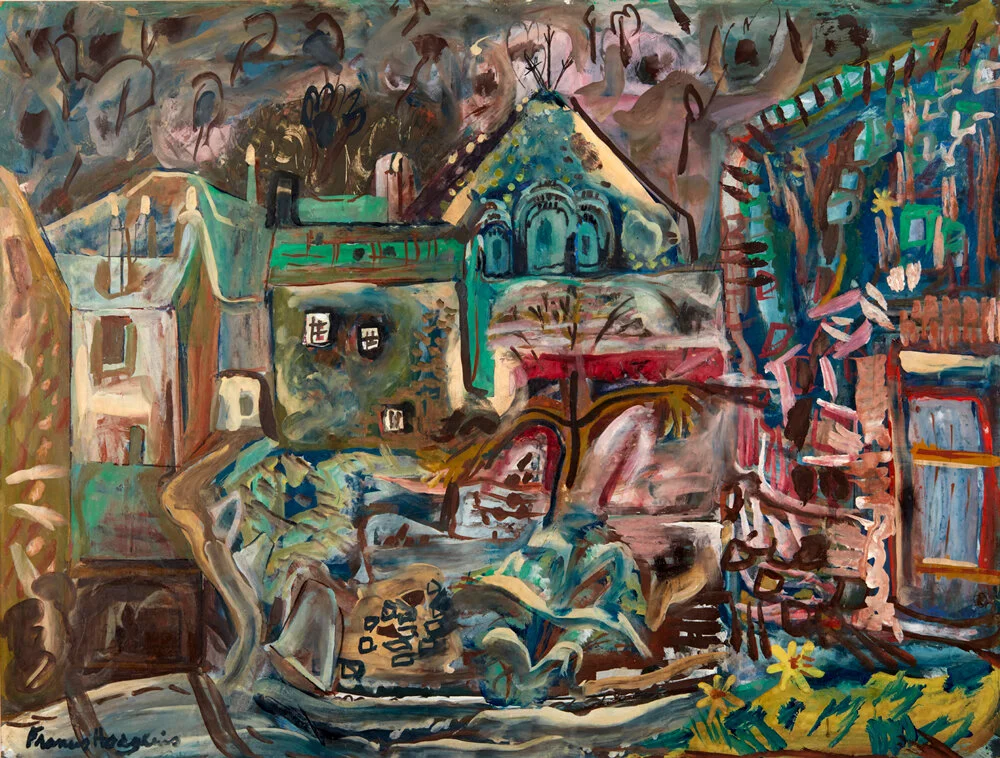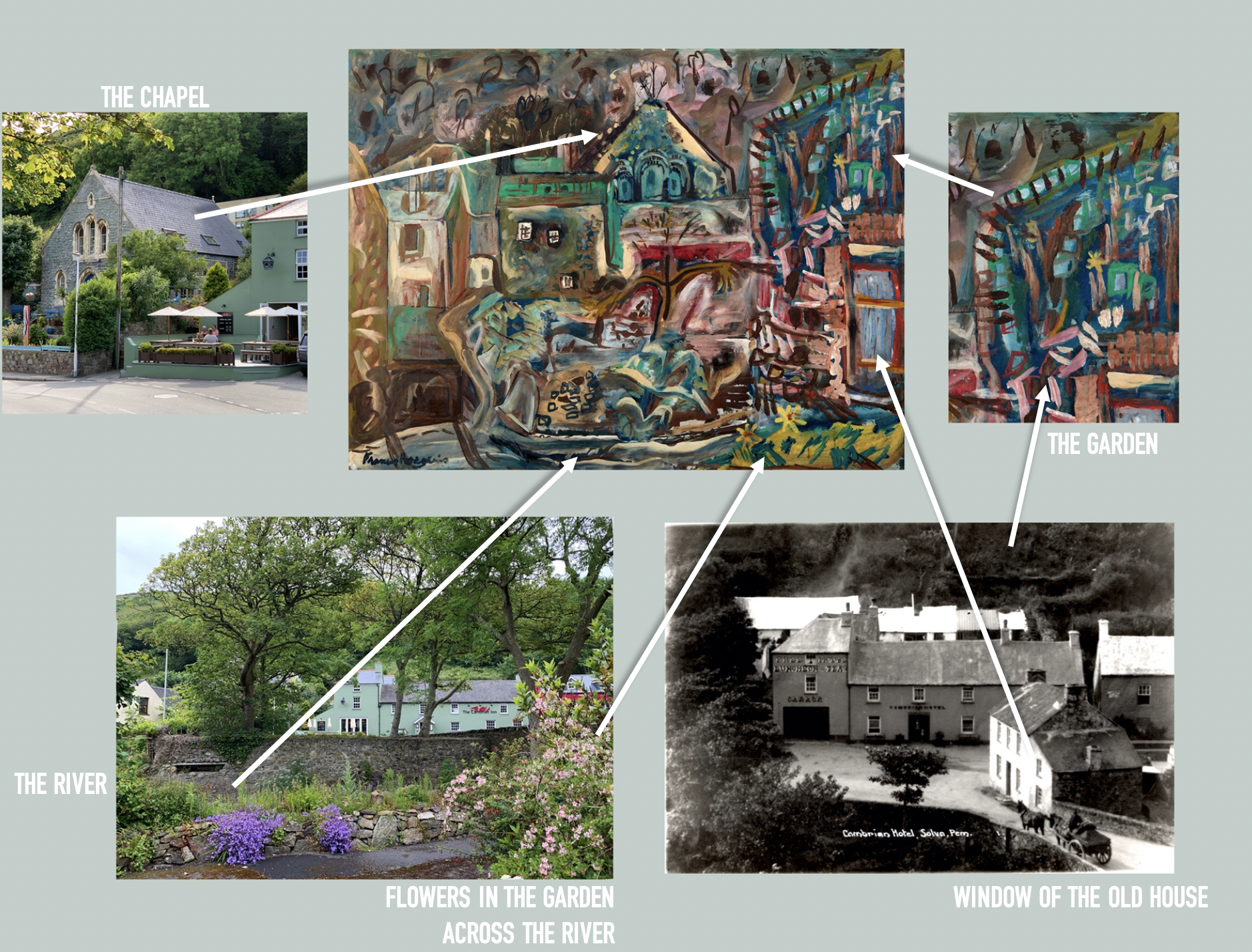Frances Hodgkins, Methodist Chapel, c.1936, Gouache on paper, 48 x 63 cm
In 2019 Jonathan Gooderham visited Solva, Wales, hoping to trace the origins of one of Frances Hodgkins’ iconic Welsh paintings – her vibrant village scene Methodist Chapel. Each year Jonathan retraces the travels of Frances Hodgkins and researches the provenance and location of her works from a particular area.
Information is sparse on Hodgkins time in Wales. From her letters Jonathan was able to ascertain that she visited Solva in the autumn of 1936. She describes Solva in a letter to her London art dealer Duncan Macdonald.
To Duncan Macdonald, c.12 November 1936, Red Lane Cottage, East Street, Corfe Castle, Dorset. Wednesday
“I have been working moderately hard, moderately successful in a landscape of steep valleys speedy rivers & castles looking like their own mountains but it takes a long long time to acquire a little idiom & rhythm in paint - if ever - Such nice gentle people I was among at Solva, mostly bird watchers & such, all terribly poor”
SOLVA
_
The Welsh village of Solva lies on the Pembrokeshire coast near St Davids, where the mouth of the River Solva meets the ocean. The area has been occupied since the Iron Age and was a popular site of plunder for Vikings. Solva grew as a trade port in the 19th century, with its sheltered harbour an ideal place for the import of resources like limestone. In 1840 direct passage to America could be taken from Solva for £4.
Looking across the Solva River into the village centre
Solva, like Hodgkins beloved Corfe Castle, has changed very little since the 1930’s, so Jonathan was hopeful he would still be able to identify many of the buildings featured in the painting. On arriving in Solva, he traversed the village in search of the distinctive form of the Methodist Chapel. As he walked down Main Street, he spotted the iconic tri-arched doors, which had rather aptly been painted a vibrant blue similar to the colour in Hodgkins painting. Known as ‘The Old Chapel’ the now deconsecrated Gothic building has become an art gallery and cafe, the Raul Speek Gallery.
The Old Chapel / Raul Speek Gallery
In her work Hodgkins distilled the Chapel’s façade, combining the features of the window and door into a tri-arched shape, with a pale dash above to indicate the top row of windows. Atop the Chapel Jonathan spotted an unusual tree branch shaped lightning conductor. The shape of the lightning rod reminded him of the stylised trees with outlined branches that became a re-occurring motif in her later works. It therefore is unsurprising that Hodgkins also noticed the uniquely shaped conductor and included it in her painting. The branch-like bars of metal act as a compositional mirror to the tree she painted at the centre of work.
A recurring feature in Methodist Chapel is Hodgkins use of tripartite composition. Painting three central blocks of blue, three buildings, three chimneys, three windows. Her theme of threes anchored in the triangular shape of the Chapel brings a sense of harmony to the composition.
Just across the road from the Chapel lies the Solva river, which Hodgkins depicted at the bottom edge of her composition. In her painting the bridge crossing the Solva River leads to a road which winds its way up to a cluster of buildings. This road eventually veers to the right and leads on to Middle Hill; a location featured in a number of her paintings of the district.
The Old Chapel and The Cambrian Inn
Jonathan identified another building featured in the painting, the green ‘Cambrian Inn’, as it sat next door to the Raul Speek Gallery/Old Chapel. In October of 1936 Frances Hodgkins had stayed at The Cambrian Inn with her friend Dorothy Selby. The accommodation had been recommended to them by her friend and fellow artist Cedric Morris. Another contemporary of Hodgkins, the artist Graham Sutherland had also stayed at The Cambrian Inn that year, and France Hodgkins was delighted to see one of his works hanging in the pub.
In Frances Hodgkins depiction of Solva, The Cambrian Inn appears to the left of the Chapel, but upon visiting the village and standing in the same viewpoint as the painting Jonathan found that the opposite was true; The Cambrian Inn actually laid to the Chapel’s right. This juxtaposition is far from unique in Frances Hodgkins oeuvre as she often painted scenes from memory at her studio in Corfe Castle, where she would distil the main features of a scene into a new composition.
On the right-hand side of the composition was an element of Hodgkins painting that had always posed a mystery; a block of blue paint outlined with strokes of red that seemed to signify the window of a hitherto unidentified structure. As so often happens, Jonathan found that a conversation in the local pub held the answer. The publican of the Cambrian Inn, Jeremy Barton produced a 1930’s photograph showing a house in front of the Inn, which he explained had been demolished in the 1940’s to make way for a small carpark. This was clearly the building on the righthand side of Hodgkins painting, with its position at the end of the bridge and an obvious similarity in the design of the windows.
The Cambrian Inn and the demolished house c.1930
Jonathan with publican Jeremy Barns
It appears Hodgkins took her sketching position for the painting from the opposite side of the river in a small garden next to the bridge. Yellow flowers from this garden can be seen in the bottom right corner of the painting. This low viewpoint looking up into the village allowed Hodgkins to capture a full view of the buildings and surrounding landscape, resulting in a composition dense with interesting elements; as if the village is rising up in front of the viewer. The blue garden in the top right of the composition appears particularly steep, as if all the vegetation might slip off and slide into the Solva river, its stitch-like garden fencing clinging to the rest of the artwork.
Methodist Chapel was selected by Sir Kenneth Clark and the British Council to be exhibited in the 1940 Venice Biennale, alongside 25 other paintings by Frances Hodgkins, including Middle Hill, Solva and Spanish Shrine. Frances Hodgkins was immensely proud of this achievement.
To William Hodgkins, 4 May 1940, Corfe Castle, Dorset.
“A very considerable compliment to your sister. One is assumed to be either eminent or dead – perhaps a bit of both – before you can qualify for this honour – this is a very important exhibition.”
Unfortunately, with political tensions rising throughout Europe, pre-war travel restrictions came into action just as the artworks were en route to Venice. Travelling in a purpose built van Methodist Chapel and the rest of Hodgkins paintings made it as far as Paris, before being diverted back to England. Alternative arrangements were made and the Biennale works were exhibited as Hertford House, London from 7th May to 8th June 1940.
Hodgkins described her disappointment with the ordeal in a letter to her brother.
To William Hodgkins, 4 May 1940, Corfe Castle, Dorset.
“News has just come that the French & British Governments have called off the show on account of the political situation, i.e suspicion of what Mussolini may be up to in the Mediterranean – isn’t it all a B-Bore!”
In 2020, eighty years later, Methodist Chapel is once again hanging ‘on the line’ reunited with several of Frances Hodgkin’s Venice Biennale paintings, such as Spanish Shrine, Courtyard Ibiza, Almond Tree and Still Life, Fish and Shells in the Auckland Art Galleries’ touring exhibition Frances Hodgkins: European Journeys.










